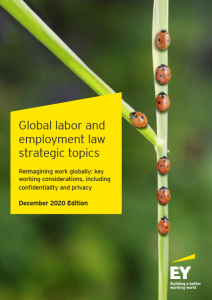Publication
In early 2020, very few people would have or could have imagined the new lifestyles brought about by the COVID-19 pandemic. Governments, organizations, families, friends and communities around the world have a new paradigm when it comes to public health, workplace safety and personal interaction.
One such area is the focus on remote working. With so many employees around the world utilizing remote working, either voluntarily or due to public health measures, employers now have more options when it comes to workforce planning. The challenge for HR teams is to provide the right information, especially for global organizations, about the risks and benefits of enabling remote working as we move through to the “Beyond” phase of the COVID-19 pandemic in 2021.
Indeed, COVID-19 has become a formidable transformation accelerator. For some organizations, remote work is being viewed as a temporary accommodation to help us “live with the virus”. The expectation for these organizations is that one day we will go back to the way we were. For other organizations, they are not “going back”! Deep transformations are underway to reimagine work and change the future of the way we work.
The design of an effective remote work program requires a balance of different considerations, including health and safety, tax, labor and employment law, privacy and confidentiality considerations, as well as cost.
In the context of advising and assisting our clients regarding remote working, our Global Labor and Employment Law teams around the world have found a number of wider issues that affect how employers manage their workforce. First, there is the cost of equipping previously office-based teams with the technology to work remotely yet saving the cost of potentially reducing the real estate footprint. Second, the importance of maintaining the organization’s culture, despite physical distance, has been the source of much thinking, such as this article from EY’s People Advisory Services colleagues. Third, there is a disparate impact of remote working depending on the sector in which the organization operates. Sometimes remote working cannot be contemplated due to the nature of the work and the employer must focus on creating a safe workplace, factory or office. Finally, the competitive global market for talent has become even steeper as the importance of a person’s physical location becomes less significant.
Despite the prevalence of remote working, there are a number of reasons why employers are planning for a physical return to the workplace. Some of the reasons why organizations are eager to go back to the office include increasing employee contact with management and the need to strategically plan and regularly conduct performance reviews, for which employers may prefer to have their employees in the office, factory or site. Of course, corporate culture plays a key role in these decisions, as well. Some organizations are willing to make drastic changes, while others are not. Regardless of the mindset or culture of an organization, what is clear is that after nine months of our immediate pivot to remote working, organizations are moving to develop robust policies for continuous remote work globally or return to office programs.
In this newsletter, we canvass the key considerations for reimaging work across 42 jurisdictions around the world.
